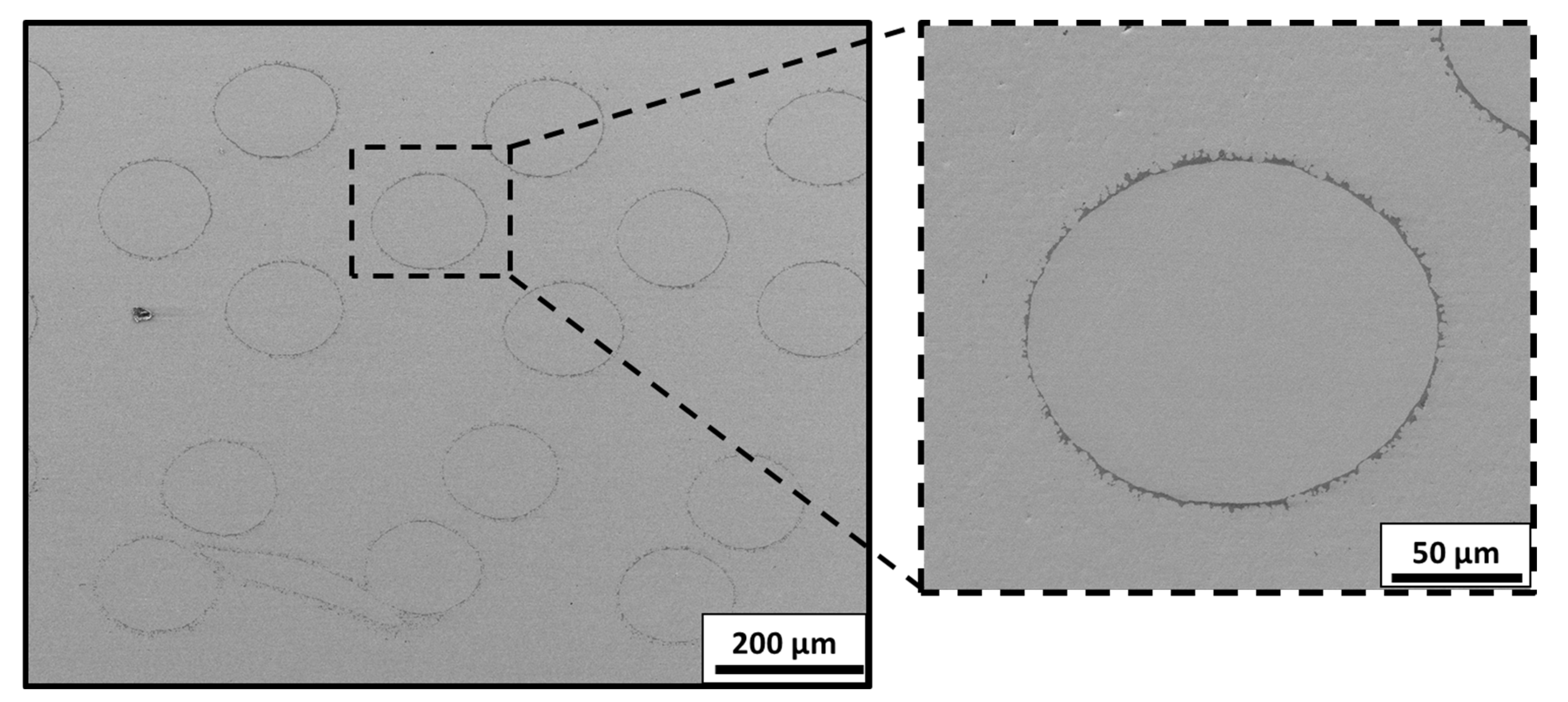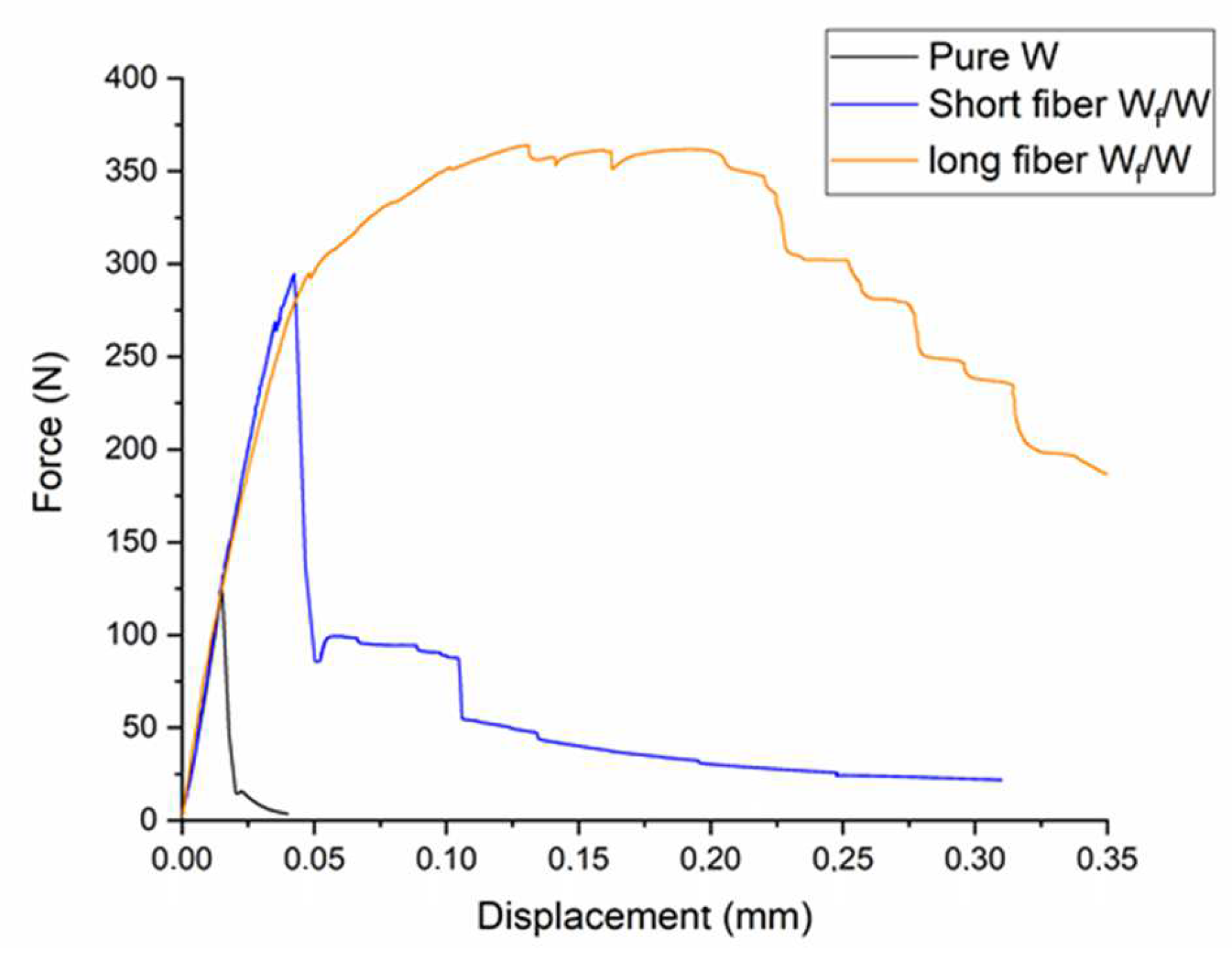Powder Metallurgy Produced Aligned Long Tungsten Fiber Reinforced Tungsten Composites
Abstract
:1. Introduction
2. Experiment
2.1. Manufacturing
2.2. Mechanical Characterization
3. Results and Discussion
4. Summary
Author Contributions
Funding
Data Availability Statement
Conflicts of Interest
References
- Schumacher, U. Status and problems of fusion reactor development. Naturwissenschaften 2001, 88, 102–112. [Google Scholar] [CrossRef] [PubMed]
- Bolt, H.; Barabash, V.; Krauss, W.; Linke, J.; Neu, R.; Suzuki, S.; Yoshida, N.; Team, A.U. Materials for the plasma-facing compo-nents of fusion reactors. J. Nucl. Mater. 2004, 329–333, 66–73. [Google Scholar] [CrossRef] [Green Version]
- Merola, M.; Loesser, D.; Martin, A.; Chappuis, P.; Mitteau, R.; Komarov, V.; Pitts, R.; Gicquel, S.; Barabash, V.; Giancarli, L.; et al. ITER plasma-facing components. Fusion Eng. Des. 2010, 85, 2312–2322. [Google Scholar] [CrossRef]
- Philipps, V. Tungsten as material for plasma-facing components in fusion devices. J. Nucl. Mater. 2011, 415, S2–S9. [Google Scholar] [CrossRef]
- Coenen, J.W.; Antusch, S.; Aumann, M.; Biel, W.; Du, J.; Engels, J.; Heuer, S.; Houben, A.; Hoeschen, T.; Jasper, B.; et al. Materials for DEMO and reactor applications—Boundary conditions and new concepts. Phys. Scr. 2016, T167, 014002. [Google Scholar] [CrossRef] [Green Version]
- Bolt, H.; Barabash, V.; Federici, G.; Linke, J.; Loarte, A.; Roth, J.; Sato, K. Plasma facing and high heat flux materials—Needs for ITER and beyond. J. Nucl. Mater. 2002, 307–311, 43–52. [Google Scholar] [CrossRef]
- Pintsuk, G.; Bobin-Vastra, I.; Constans, S.; Gavila, P.; Rödig, M.; Riccardi, B. Qualification and post-mortem characterization of tungsten mock-ups exposed to cyclic high heat flux loading. Fusion Eng. Des. 2013, 88, 1858–1861. [Google Scholar] [CrossRef]
- Huber, A.; Arakcheev, A.; Sergienko, G.; Steudel, I.; Wirtz, M.; Burdakov, A.; Coenen, J.; Kreter, A.; Linke, J.; Mertens, P. Investi-gation of the impact of transient heat loads applied by laser irradiation on ITER-grade tungsten. Phys. Scr. 2014, T159, 014005. [Google Scholar] [CrossRef] [Green Version]
- Ren, C.; Fang, Z.Z.; Koopman, M.; Butler, B.; Paramore, J.; Middlemas, S. Methods for improving ductility of tungsten—A review. Int. J. Refract. Met. Hard Mater. 2018, 75, 170–183. [Google Scholar] [CrossRef]
- Mao, Y.; Coenen, J.W.; Riesch, J.; Sistla, S.; Almanstötter, J.; Jasper, B.; Terra, A.; Höschen, T.; Gietl, H.; Bram, M.; et al. Development and characterization of powder metallurgically produced discontinuous tungsten fiber reinforced tungsten composites. Phys. Scr. 2017, T170, 014005. [Google Scholar] [CrossRef]
- Riesch, J.; Buffiere, J.-Y.; Höschen, T.; Di Michiel, M.; Scheel, M.; Linsmeier, C.; You, J.-H. In situ synchrotron tomography estimation of toughening effect by semi-ductile fibre reinforcement in a tungsten-fibre-reinforced tungsten composite system. Acta Mater. 2013, 61, 7060–7071. [Google Scholar] [CrossRef] [Green Version]
- Mao, Y.; Coenen, J.; Riesch, J.; Sistla, S.; Almanstötter, J.; Jasper, B.; Terra, A.; Höschen, T.; Gietl, H.; Linsmeier, C.; et al. Influence of the interface strength on the mechanical properties of discontinuous tungsten fiber-reinforced tungsten composites produced by field assisted sintering technology. Compos. Part A Appl. Sci. Manuf. 2018, 107, 342–353. [Google Scholar] [CrossRef]
- Gietl, H.; Riesch, J.; Coenen, J.; Höschen, T.; Linsmeier, C.; Neu, R. Tensile deformation behavior of tungsten fibre-reinforced tungsten composite specimens in as-fabricated state. Fusion Eng. Des. 2017, 124, 396–400. [Google Scholar] [CrossRef]
- Mao, Y.; Coenen, J.W.; Riesch, J.; Sistla, S.K.; Almanstötter, J.; Reiser, J.; Terra, A.; Chen, C.; Wu, Y.; Raumann, L.; et al. Fracture behavior of random distributed short tungsten fiber-reinforced tungsten composites. Nucl. Fusion 2019, 59, 086034. [Google Scholar] [CrossRef]
- Mao, Y.; Coenen, J.W.; Terra, A.; Gao, L.; Kreter, A.; Wirtz, M.; Liu, C.; Chen, C.; Riesch, J.; Wu, Y.; et al. Demonstrating tungsten fiber-reinforced porous-matrix tungsten composites for future fusion application. Nucl. Fusion 2022, 62, 106029. [Google Scholar] [CrossRef]
- Riesch, J.; Han, Y.; Almanstötter, J.; Coenen, J.W.; Höschen, T.; Jasper, B.; Zhao, P.; Linsmeier, C.; Neu, R. Development of tungsten fibre-reinforced tungsten composites towards their use in DEMO—Potassium doped tungsten wire. Phys. Scr. 2016, T167, 014006. [Google Scholar] [CrossRef] [Green Version]
- Mao, Y.; Coenen, J.W.; Riesch, J.; Sistla, S.; Chen, C.; Wu, Y.; Raumann, L.; Neu, R.; Linsmeier, C.; Broeckmann, C. Spark Plasma Sintering Produced W-Fiber-Reinforced Tungsten Composites. In Spark Plasma Sintering of Materials: Advances in Processing and Applications; Cavaliere, P., Ed.; Springer International Publishing: Cham, Switzerland, 2019; pp. 239–261. [Google Scholar]
- Guillon, O.; Gonzalez-Julian, J.; Dargatz, B.; Kessel, T.; Schierning, G.; Räthel, J.; Herrmann, M. Field-Assisted Sintering Tech-nology/Spark Plasma Sintering: Mechanisms, Materials, and Technology Developments. Adv. Eng. Mater. 2004, 16, 830–849. [Google Scholar] [CrossRef] [Green Version]
- Jiang, Y.; Zhang, L.; Fang, Q.; Zhang, T.; Wang, X.; Hao, T.; Liu, C. Toughness enhancement of tungsten reinforced with short tungsten fibres. Mater. Sci. Eng. A 2017, 690, 208–213. [Google Scholar] [CrossRef]
- Mao, Y.; Coenen, J.; Sistla, S.; Liu, C.; Terra, A.; Tan, X.; Riesch, J.; Hoeschen, T.; Wu, Y.; Broeckmann, C.; et al. Design of tungsten fiber-reinforced tungsten composites with porous matrix. Mater. Sci. Eng. A 2021, 817, 141361. [Google Scholar] [CrossRef]
- Mao, Y.; Coenen, J.W.; Riesch, J.; Sistla, S.; Almanstötter, J.; Terra, A.; Chen, C.; Wu, Y.; Raumann, L.; Höschen, T.; et al. Fiber Volume Fraction Influence on Randomly Distributed Short Fiber Tungsten Fiber-Reinforced Tungsten Composites. Adv. Eng. Mater. 2020, 22, 1901242. [Google Scholar] [CrossRef]
- Laws, V. The efficiency of fibrous reinforcement of brittle matrices. J. Phys. D Appl. Phys. 1971, 4, 1737–1746. [Google Scholar] [CrossRef]
- Riesch, J.; Almanstötter, J.; Coenen, J.W.; Fuhr, M.; Gietl, H.; Han, Y.; Höschen, T.; Linsmeier, C.; Travitzky, N.; Zhao, P.; et al. Properties of drawn W wire used as high performance fibre in tungsten fibre-reinforced tungsten composite. IOP Conf. Ser. Mater. Sci. Eng. 2016, 139, 012043. [Google Scholar] [CrossRef] [Green Version]
- Mao, Y.; Engels, J.; Houben, A.; Rasinski, M.; Steffens, J.; Terra, A.; Linsmeier, C.; Coenen, J. The influence of annealing on yttrium oxide thin film deposited by reactive magnetron sputtering: Process and microstructure. Nucl. Mater. Energy 2017, 10, 1–8. [Google Scholar] [CrossRef]
- DIN 50115; Notched Bar Impact Testing of Metallic Materials Using Test Pieces other than ISO Test Pieces. Deutsches Institut fur Normung: Berlin, Germany, 1991.
- Rieth, M.; Hoffmann, A. Influence of microstructure and notch fabrication on impact bending properties of tungsten materials. Int. J. Refract. Met. Hard Mater. 2010, 28, 679–686. [Google Scholar] [CrossRef]
- ASTM E399-17; Standard Test Method for Linear-Elastic Plane-Strain Fracture Toughness KIc of Metallic Materials. ASTM International: West Conshohocken, PA, USA, 2017.
- Gietl, H.; Olbrich, S.; Riesch, J.; Holzner, G.; Höschen, T.; Coenen, J.; Neu, R. Estimation of the fracture toughness of tungsten fibre-reinforced tungsten composites. Eng. Fract. Mech. 2020, 232, 107011. [Google Scholar] [CrossRef]
- Meraghni, F.; Blakeman, C.J.; Benzeggagh, M.L. Effect of interfacial decohesion on stiffness reduction in a random discontin-uous-fibre composite containing matrix microcracks. Compos. Sci. Technol. 1996, 56, 541–555. [Google Scholar] [CrossRef]
- Zhang, H.; Zhang, Z.; Breidt, C. Comparison of short carbon fibre surface treatments on epoxy composites: I. Enhancement of the mechanical properties. Compos. Sci. Technol. 2004, 64, 2021–2029. [Google Scholar] [CrossRef]
- Hu, X.; Fang, J.; Xu, F.; Dong, B.; Xiao, Y.; Wang, L. Real internal microstructure based key mechanism analysis on the mi-cro-damage process of short fibre-reinforced composites. Sci. Rep. 2016, 6, 34761. [Google Scholar] [CrossRef]
- Nguyen, B.N.; Bapanapalli, S.K.; Holbery, J.D.; Smith, M.T.; Kunc, V.; Frame, B.J.; Phelps, J.H.; Tucker, C.L., III. Fiber Length and Orientation in Long-Fiber Injection-Molded Thermoplastics—Part I: Modeling of Microstructure and Elastic Properties. J. Compos. Mater. 2008, 42, 1003–1029. [Google Scholar] [CrossRef]
- Gray, R.J. Analysis of the effect of embedded fibre length on fibre debonding and pull-out from an elastic matrix. J. Mater. Sci. 1984, 19, 861–870. [Google Scholar] [CrossRef]




| Samples | Fracture Energy Density (kJ/m2) | Fracture Toughness, Kq (MPa m0.5) | Flexural Strength (Mpa) | ||||
|---|---|---|---|---|---|---|---|
| Pure Tungsten | 0.1 ± 0.0 | 5.5 ± 0.0 | 381 ± 46 | ||||
| Short fiber Wf/W | 1.9 ± 0.7 | 25.5 ± 7.8 | 221 ± 17 | ||||
| Long fiber Wf/W | 13.2 | 10.2 | 82.5 | 52.6 | 412 | 473 | 600 |
| 11.6 ± 1.5 | 67.6 ± 15.0 | 495 ± 78 | |||||
Publisher’s Note: MDPI stays neutral with regard to jurisdictional claims in published maps and institutional affiliations. |
© 2022 by the authors. Licensee MDPI, Basel, Switzerland. This article is an open access article distributed under the terms and conditions of the Creative Commons Attribution (CC BY) license (https://creativecommons.org/licenses/by/4.0/).
Share and Cite
Mao, Y.; Coenen, J.W.; Liu, C.; Terra, A.; Tan, X.; Riesch, J.; Höschen, T.; Wu, Y.; Broeckmann, C.; Linsmeier, C. Powder Metallurgy Produced Aligned Long Tungsten Fiber Reinforced Tungsten Composites. J. Nucl. Eng. 2022, 3, 446-452. https://doi.org/10.3390/jne3040030
Mao Y, Coenen JW, Liu C, Terra A, Tan X, Riesch J, Höschen T, Wu Y, Broeckmann C, Linsmeier C. Powder Metallurgy Produced Aligned Long Tungsten Fiber Reinforced Tungsten Composites. Journal of Nuclear Engineering. 2022; 3(4):446-452. https://doi.org/10.3390/jne3040030
Chicago/Turabian StyleMao, Yiran, Jan W. Coenen, Chao Liu, Alexis Terra, Xiaoyue Tan, Johann Riesch, Till Höschen, Yucheng Wu, Christoph Broeckmann, and Christian Linsmeier. 2022. "Powder Metallurgy Produced Aligned Long Tungsten Fiber Reinforced Tungsten Composites" Journal of Nuclear Engineering 3, no. 4: 446-452. https://doi.org/10.3390/jne3040030







